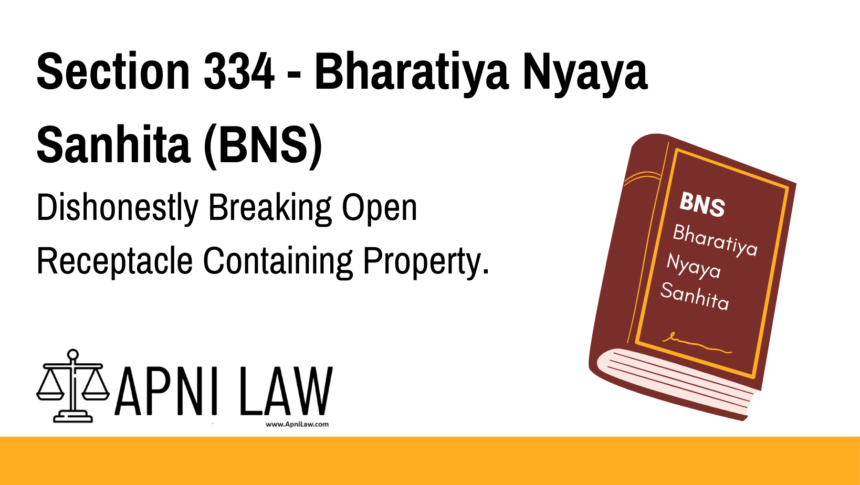Code: Section 334 BNS
(1) Whoever dishonestly or with intent to commit mischief, breaks open or
unfastens any closed receptacle which contains or which he believes to contain property,
shall be punished with imprisonment of either description for a term which may extend to two
years, or with fine, or with both.
(2) Whoever, being entrusted with any closed receptacle which contains or which he
believes to contain property, without having authority to open the same, dishonestly, or with
intent to commit mischief, breaks open or unfastens that receptacle, shall be punished with
imprisonment of either description for a term which may extend to three years, or with fine, or
with both.
Explanation of Section 334 BNS
Section 334 BNS focuses on cases where individuals illegally open or tamper with closed receptacles containing property, either to:
- Steal, damage, or misappropriate the contents, or
- Commit mischief with the intention of causing harm.
The section applies in two key scenarios:
- General Case: When a person breaks into a receptacle without authorization to commit mischief.
- Entrusted Case: When someone is entrusted with the receptacle (like an employee or caretaker) but dishonestly breaks it open without permission.
Illustrations
- Example 1: Breaking a Locked Box
- Scenario: A finds a locked box in a store. He forcibly opens it, believing it contains money, intending to steal.
- Punishment: Up to 2 years of imprisonment or a fine, or both.
- Example 2: Employee’s Misconduct
- Scenario: B is a cashier at a shop. He has access to the cash register but illegally opens it to steal money without permission.
- Punishment: Up to 3 years of imprisonment or a fine, or both.
- Example 3: Breaking an Old Safe
- Scenario: C has an old safe at home. He breaks it open without authorization to damage its contents, intending mischief.
- Punishment: Up to 2 years of imprisonment or a fine, or both.
- Example 4: Damage to Property
- Scenario: D, entrusted with a warehouse, breaks open sealed containers just to cause damage out of frustration.
- Punishment: Up to 3 years of imprisonment or a fine, or both.
Common Questions and Answers on Section 334 BNS
1. What is the difference between Section 334 and regular theft?
- Answer: Section 334 deals with breaking open a receptacle dishonestly, whether or not the property is stolen. It focuses on the act of breaking and intent to commit mischief, not just theft.
2. Does the law apply if the receptacle is empty?
- Answer: Yes, the section applies even if the receptacle is empty, as long as there was an intent to commit mischief or dishonesty.
3. Can an employee be punished under this section?
- Answer: Yes, especially if they are entrusted with the receptacle and break it without authority.
4. What counts as “intent to commit mischief”?
- Answer: It includes any action aimed at causing harm, damage, or loss to the property or its owner, even if no theft occurs.
5. Is a fine mandatory along with imprisonment?
- Answer: No, the court may impose either imprisonment, fine, or both based on the case circumstances.
Conclusion
Section 334 BNS aims to protect property by punishing individuals who dishonestly break into closed receptacles with the intent to commit mischief. It covers both general cases of unauthorized entry and situations where a person is entrusted with property but violates that trust.
For more legal updates, visit ApniLaw! ⚖️








